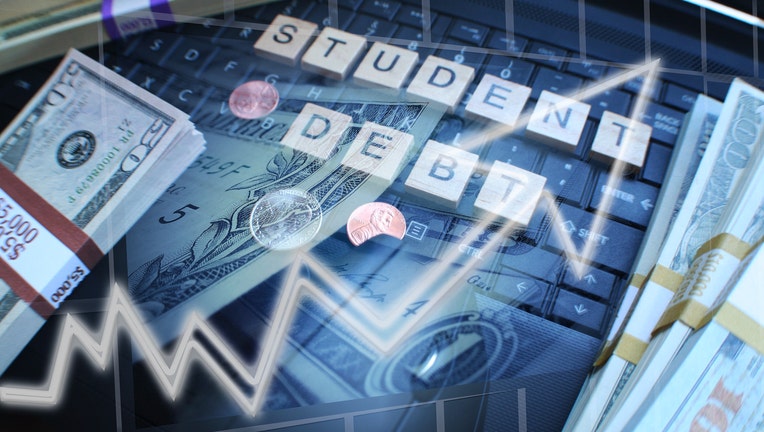Second coronavirus stimulus check could be coming — what you should do to save more money now

If your loans aren’t forgiven, you still have options.(iStock)
If the Senate passes the HEROES Act — a $3 trillion stimulus bill passed by the House of Representatives — eligible student loan borrowers could get some of their debt wiped off the books. The Act includes forgiveness of $10,000 of federal student loans and $10,000 of private student loans.
While the final decision is currently unknown, there are other steps you can take now to address and even reduce your student loan debt:
Refinance your student loans
If you have a private student loan, you may be able to obtain a lower interest rate or lower your monthly payments if you refinance. To see what kind of rates you qualify for today, plug your information into this free online tool. Note: If you’re currently unemployed or furloughed due to COVID-19, you may not qualify. But if you’re employed and have good credit, it’s an option to consider.
SHOULD YOU CONSOLIDATE OR REFINANCE YOUR STUDENT LOANS?
To reduce your interest rate significantly, though, you’ll likely need to take a loan with a shorter term. This could increase your monthly payments, but it would reduce the total amount you would pay. Plus you’ll pay off the loan faster. If you have additional funds, this could be a good option.
If you need to reduce your monthly payment, it could be possible to refinance to a loan with a longer-term. While you would pay more interest over the course of the loan, you’ll have a lower payment, which will free up money. It’s a tradeoff you have to weigh to determine if it makes financial sense for you now.
The variety of plans available can be confusing. Use Credible to compare your refinancing options and shop around for the best lender.
Split your student loan payments to twice a month
If you have the ability to send payments bi-weekly, you can pay off your student loan faster. While loan payments are due monthly, you can split the payment in two and send each half every two weeks. For example, if your payment is $500, send $250 every other week. Since there are 52 weeks in the year, this will result in 13 payments instead of 12 (when paid once a month).
THIS IS WHY STUDENT LOAN REFINANCING RATES ARE GOING DOWN
Check your loan documents or call your lender to make sure you can pay this way. You’ll also want to make sure your additional payments are applied to your principal, and not credited for future payments.
If you have private student loans, you may want to look into student loan refinancing as a way to lower your monthly payment. With Credible's free online tool, you can compare multiple lenders and refinance rates within minutes.
Pause your student loan payments
The CARES Act set the interest rate for federal student loans at 0 percent, but you can also pause your payments. Student loan borrowers don’t have to make payments until September 30, 2020. You can also request a refund of student loan payments you made after March 13, 2020, and use the money for other bills.
If you have FFELP loans, you can apply for a Direct Consolidation Loan, which organizes all of your separate federal student loans into one loan with one monthly payment and a single loan servicer. The drawback to this option is that your interest rate will be calculated on the weighted average of all of your loan rates and rounded up to the nearest .125 percent. Once you have a Direct Consolidation Loan, you are eligible under the CARES Act for 0 percent interest as well as the ability to pause payments.
Enroll in an income-driven repayment plan
If you’re struggling to pay your federal student loans because your income is low, you can enroll in an income-driven repayment plan. Based on your income and family size, payments are set to an amount that is considered affordable.
10 OF THE BEST STUDENT LOAN REFINANCE COMPANIES
The government offers four programs — the Income-Based Repayment (IBR), Pay As You Earn (PAYE), Revised Pay As You Earn (REPAYE), and Income-Contingent Repayment (ICR) — with revised monthly payments between 10 and 20 percent of discretionary income, depending on the program.
Receive tax-free student loan forgiveness
Depending on your occupation, you may qualify for forgiveness for federal student loans. For example, U.S. federal, state, local, or tribal government or not-for-profit organization employees might be eligible under the Public Service Loan Forgiveness Program. And teachers at low-income schools or educational service agencies can apply for the Teacher Loan Forgiveness Program. Other forgiveness programs exist, as well, and it’s an option student loan borrowers should investigate.
WHY YOU'LL LIKELY SAVE MONEY IF YOU REFINANCE STUDENT LOANS NOW
The Senate is expected to vote on the HEROES Act this month. If your student loan isn’t forgiven, you can take it upon yourself to get rid of it by paying it faster or at a lower interest rate. Consider your education a good investment in your future.

